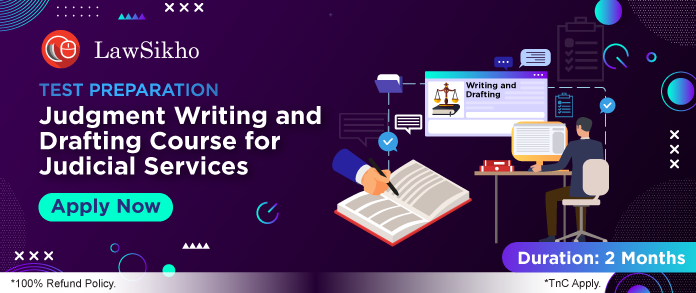This article is written by Harshini Naidu, Faculty of Law, Maharaja Sayajirao University of Baroda.
Dated: 22/09/2020
The Guest Speaker:
Pranav M. Khatavkar is currently working as a Senior Manager in the Legal Risk Management department of YES BANK. He has authored four law books in the area of Insolvency and Bankruptcy Code and got them published. Pranav holds an LLM from Northwestern University, Chicago, U.S.A. His previous work experience also includes working at White & Case, LLP, New York.
The Host:
Abhyuday Agarwal is the co-founder of the legal platform, LawSikho. He along with Ramanuj Mukherjee started the chain of legal platforms to make the legal profession accessible to everyone. He graduated from West Bengal National University of Juridical Sciences in 2011 and ventured with various startups such as SuperLawyer, LawSikho, iPleaders, and CloudTrain. He has written numerous articles, blogs, research material all across the internet on multiple topics associated with the law.
Table of Contents
How did you deal with the self-doubt, which a young Lawyer faces while planning to write a book?
I identified this issue and worked on not letting it bring me down. Anyone can write if you have the required knowledge and good writing skills. If a good and solid proposal is submitted to the publisher, then there is a good number of chances that the publisher will agree to publish the book and it will not matter if the book is written by a young lawyer or a senior lawyer.
How did you deal with the knowledge gap?
Luckily, the subject on which I started writing was a niche topic and everyone was on the same level when it came to knowledge. Insolvency and Bankruptcy Code was passed by the Rajya Sabha in May 2016 and my first book entered the market in the month of August 2016. So yes, it was indeed a good timing for me.
What is the importance of topic identification while writing a book?
It is very important to identify and select the topic as it is the topic that makes the whole process of writing a book easier. There is a very important approach that can be used while identifying a topic. This approach is called – CAT. CAT stands for Content, Audience, and Timing. Content is about what is to be covered in the book, what you know about, and what do you wish to write about. Target is about the audience you wish to reach through the book, the stakeholders, and the people who will be buying your book. Timing is important while selecting a topic as you need to take into consideration different aspects like at what time would you be publishing the book and releasing it in the market, how relevant will the topic be at the time of the release of the book, and what the market situation be like at the time of releasing the book.
While identifying a topic in your area of interest, if you select the topic keeping in mind different critical developments and amendments in the sector which have come up in the recent years then it an advantage for you as not many people are aware of the details and your audience base tends to increase.
Abhyuday: Think from a prospective client’s point of view and not as a lawyer, this helps in developing a bond with a prospective client through your knowledge. When they come across any matter which was covered by you in the book, the prospective client will remember you and might approach you for the same. 5% effort in the process of writing a book is of identifying a suitable topic and this 5% is what makes the rest 95% of the work easy.
What can be done when there are many books already written on a niche topic by experts in the area of your interest?
There are multiple ways in which we can find a solution to this problem. If there is a book already in the market on the topic you wish to write then you need to work on a different approach in which the book can be written. For example, if there is a topic in law on which you wish to write a book but is already covered by several subject matter experts, then one should focus on writing it in a way that is easier to understand for the reader. The writer should focus on simplifying the content which is already available for the readers to choose from in the market. Reading a book written by an expert and understanding what has the author missed to cover works great while planning to sort out the C part of the CAT strategy.
If you can summarize, simplify, and explain a layman about a technical topic through graphical representation and other forms of presentations then you should not doubt your skills and start writing in a step by step manner. If you fail to find a solid topic to write on in the area of your interest and expertise, you can always try focusing on improvising the content already available for the audience or the readers. The question that you frame for the book, the question which you will be answering in the book will change your output and increase your speed while writing the book.
How to develop a structure for writing a book?
Firstly, one has to be crystal clear about the law they are planning to write on and a narrow topic has to be identified on which the book will be based. Even a narrow topic is a larger topic when you are writing a book due to which the topic might contain sub-topics under it. Identifying the sub-topics under a particular area of law makes it easier to form a structure of the book. We can then start designing a proper step by step process in which the writing work will proceed further.
When you start writing a book, you come across various issues in the prescribed law such as important aspects which are not covered, critical judgments which are not discussed and these could become a sub-topic of the book. Through going deeper into the topic, one may find multiple conflicting insights like disputes or a grey area within a particular scholarship and these can be included in the outline of the book.
How long did it take to complete writing the book?
I used to write for around 3 hours a day for 2.5 months. Each of the four books on Insolvency and Bankruptcy Code were completed in 3 months. Keeping a target of 3 months has always helped as a longer deadline of 6-7 months gives an opportunity to procrastinate. A short to medium term goal helps us in staying motivated and keeps us on our toes as it requires a lot of attention, determination, and hard work. The time which one dedicates to write in a day should be free from all kinds of distractions and full of concentration.
How should an author approach publishers?
There is a standard approach when it comes to approaching publishers for publishing a book. One has to complete at least two chapters before approaching an author and pitching the book to them. An author should be able to explain to the publishers about the markets in which the book can be launched, the market where the audience will be willing to buy the book, and the competitions. Publishers require concise information about the total number of pages in the book. International Publishers have a target that there should be at least 500 pages in the book including the annexures.
An easy way in which we could get in touch with a publisher is through approaching law booksellers as they have contacts through which the bookseller may refer you to the publisher. Talking about the time taken by the publishers in sharing their decision, the larger the Publisher house more longer does it take to receive a response from them has a hierarchy followed in all the companies and organizations.
What should one keep in mind before signing a publication contract?
There are mainly three things an author should keep in mind before signing a publication contract. These are –
- Royalty clause: The standard royalty that all publisher houses give is either 10% of the cost price or after deducting the trade discount. And in some cases, there is a fixed amount of royalty awarded to the author irrespective of copies of the book sold.
- Copyright clause: The copyright clause in the publication contract decides if the copyright of the book stays with the author or with the publisher.
- Right of first refusal clause: Right of first refusal is a restrictive clause wherein future if the author writes another book then he/she has to approach the same publisher first and only after their refusal can the author approach other publishers.
How can an author self publish a book online?
Abhyuday: I have experience in self-publishing a book in 2018. The book was self-published by me on Amazon where I had to log into Amazon, make sure the book was in a word file that can be converted into a Kindle Version through a KDP(Kindle Desktop Publishing) software. The KDP software renders the .doc file into a Kindle-friendly version. After this step, the author has to check and give suitable headings to the different chapters. The software picks up the headings and adds a table of contents automatically where changes can be made manually if required.
After the editing is completed and finalized, one has to upload it on the Amazon Kindle and select to publish the same. Within 24 hours, Amazon responds to the request to self publish a book. By default, Amazon gives 30% royalty to the author of the book and you are free to decide the price of the book. It is necessary to keep in mind that the work of the author does not end with self-publishing. Most of these agreements are non-exclusive so the author has the option to approach other platforms to publish the book on their platform. The author has to take up the task of marketing the book and spreading awareness about the same in the market.
LawSikho has created a telegram group for exchanging legal knowledge, referrals and various opportunities. You can click on this link and join:
 Serato DJ Crack 2025Serato DJ PRO Crack
Serato DJ Crack 2025Serato DJ PRO Crack











 Allow notifications
Allow notifications



